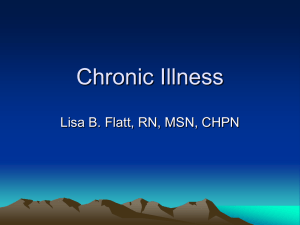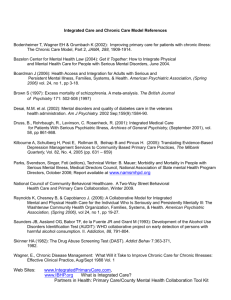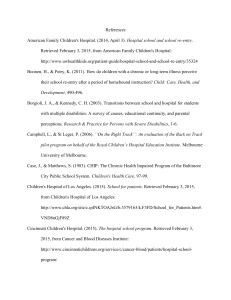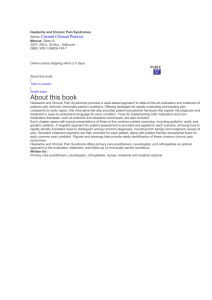What is chronicity
advertisement
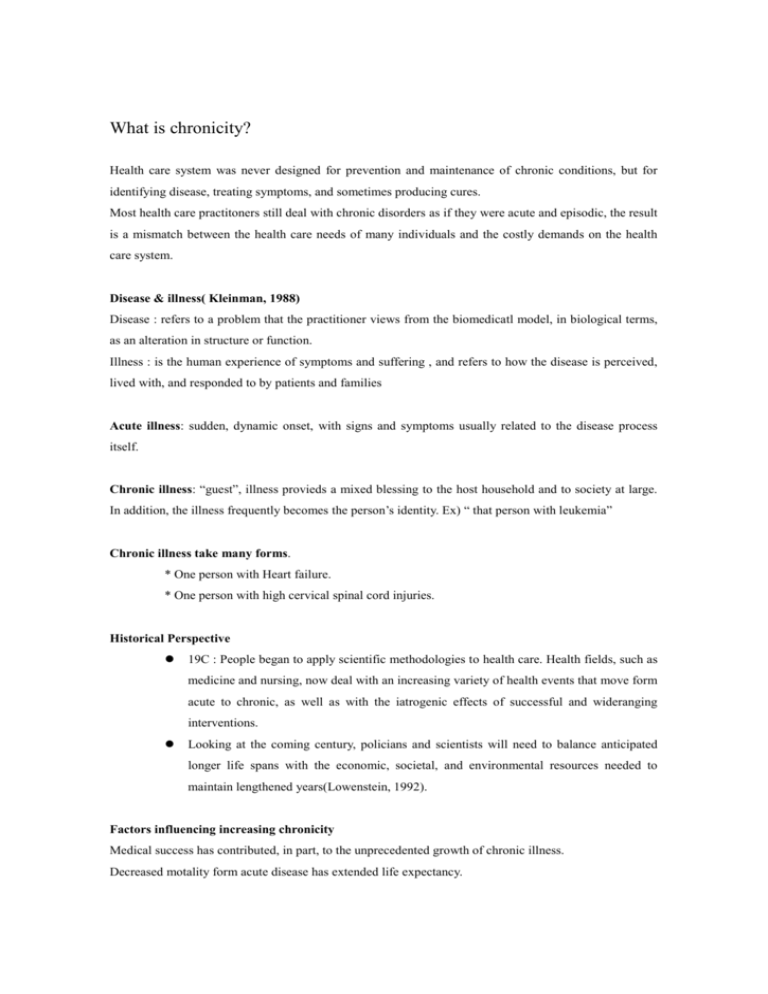
What is chronicity? Health care system was never designed for prevention and maintenance of chronic conditions, but for identifying disease, treating symptoms, and sometimes producing cures. Most health care practitoners still deal with chronic disorders as if they were acute and episodic, the result is a mismatch between the health care needs of many individuals and the costly demands on the health care system. Disease & illness( Kleinman, 1988) Disease : refers to a problem that the practitioner views from the biomedicatl model, in biological terms, as an alteration in structure or function. Illness : is the human experience of symptoms and suffering , and refers to how the disease is perceived, lived with, and responded to by patients and families Acute illness: sudden, dynamic onset, with signs and symptoms usually related to the disease process itself. Chronic illness: “guest”, illness provieds a mixed blessing to the host household and to society at large. In addition, the illness frequently becomes the person’s identity. Ex) “ that person with leukemia” Chronic illness take many forms. * One person with Heart failure. * One person with high cervical spinal cord injuries. Historical Perspective 19C : People began to apply scientific methodologies to health care. Health fields, such as medicine and nursing, now deal with an increasing variety of health events that move form acute to chronic, as well as with the iatrogenic effects of successful and wideranging interventions. Looking at the coming century, policians and scientists will need to balance anticipated longer life spans with the economic, societal, and environmental resources needed to maintain lengthened years(Lowenstein, 1992). Factors influencing increasing chronicity Medical success has contributed, in part, to the unprecedented growth of chronic illness. Decreased motality form acute disease has extended life expectancy. Incidentally, living longer has led to greater vulnerability of people to have accident and disease events that can accumulate chronic conditions. Controlling smoking tobacco and such disorder as hepatitis B infections, hypertension, elevated blood cholesterol will greately lower global chronic disease rates. Statistics indicate that about one in every seven persons of all ages has a disabling condition that limits life activities. In addition, it should be noted that chronic disabilities are disporportionately found among minorities, the lower socioeconomic populations, and the elderly(Institute of Medicin, 1991). Perceptions of chronic illness Health professionals can view chronicity Positively or Negatively. Deficulty Defining Chronicity 1. Commission on Chronic illness(1949) " All impairments or deviations from normal that have the following characteristics: permanency, residual disability caused by nonreversible pathological alteration, require rehabilitation, and may require a long period of supervision, observation, or care" 2. National conference on Care of the Long Term Patient(1954) " Requires a continuous or prolonged period of care, at least 30 acute hospital days, or 3 months of medical supervision and /or rehabilitation in a different setting .." 3. Nursing perspective " Chronic illness is the irreversible presence, accumulation, or latency of disease states or impairments that involve the total human environment for supportive care and self-care, maintenance of function, and prevention of further disability.." Impact of chronic illness Chronic condition affects the social, psychological, physical, and economic aspects of a person’s life, often in a cyclical manner. Problems inevitably faced include intrafamily an sexual stresses, social isolation, independence versus dependence conflicts, enforced self-image insults and modifications, economic pressure, and the threat of death(Levey, 1979). Case history of J.O. illustrates the impact of progressive disability on the individual, the family and the community, and the interrelatedness of aspects of illness on one client’s life. “ I’ll live with it.” This successful accommodation of different levels of normality allows J.O. to face and participate in day-to-day problem solving. Issues of Quality and Quantity of Life Quality of life goals may prove to be the standard for measuring the performance of health care(Institute of Medicine, 1991), since quality includes the functional capacity and independence of the affected person and provides a means for evaluating achievement of the person’s goals. Professional caregivers face changing dilemmas as medical technology creates new methods to preserve and prolong life. Impact on the Clinet 1. Infancy through Adolescence [ Infancy] - under 18 years 31% - 4 most prevalent chronic conditions : - - : one or more chronic conditions ( Newacheck & Taylor, 1992) hay fever / chronic sinusitis / chronic bronchitis / asthma Stein(1989) …the unique period of childhood, growth and development needs require sequence of care different from other age groups - Effective management may help define the needed levels of care, including assistance with medical and nursing services, respite and day care, education, life planning, financial and legal services, speech therapy, transportation, recreational activities, and advocacy causes(Marcenko & Smith, 1992). [Adolescence] - The adocescent who has a chronic disease faces the dual role of normal development and acceptance of a life with limitation. - Stein(1989) identified eight social experience that are important for the transition from childhood to a adulthood: - In consideration of normal adolescent socialization steps, opportunities to involve the chronically ill adolescent in all areas are vital to adjustment and fulfillment as an adult. - Case study of M.T. 2. Young to Middle-Aged Adults - a time of high activity and productivity - According to 1989 data, chronic sinusitis and orthopedic deformities or impairments were the most prevalent chronic illnesses among young to middle-aged adults( National Health Survey, 1993). - The presence of a chronic condition can complicate the conception and completion of goals and dreams. - Case study of T.Y. 3. Older Adults - chronic disorders are frequently multiple. - 45 to 75 aged person : prevalent chronic conditions are arthritis, hypertension, hearing impariment and heart conditions(Department of Commerce, 1992). - In general, society wiews both the aged and chronically ill negatively. - At this time of increasing financial concerns and rationing of dollars, health care workers must put into perspective the ethical issues of age and function and quality of life over economic decision making(Binstock & Post, 1991). Sociocultural Impact Disease-specific focus -> disadvantage Modified rather than nonproductive -> leads to maximization of well-being, creativity, and productivity. 1. Use of Health Services - Utilization of services varies by sex and age. - In fact, health workers attitudes toward chronic illness and the chronically ill are influenced by the environments they work in. 2. Rehabilitation -Rehabilitation for the chronically ill can paly a major role in restroing or maintaining function. 3. Cultural View of Illness - Illness belief systems form the cultural milieu that define caregivers’ and individuals’ attitudes toward illness. Conception about the source of disease and required treatment affect the types of therapy the care-giver offers as well as the outcome the client expects. Political Impact -National policies and financing for prevention of early-onset morbidity could be cost effective. -Interventions must be directed to decreasing the source and amount of disability Financial Cost -Illness is expensive -Many families struggling with chronic illness face reduction of income and benefits, change to poorer housing, marital instability, and decreased opportunities to educate their children. Intervention - Interventions on behalf of the chronically ill require responsible management by health providers and responsible achievement by the involved individual. - Temple and Burkitt(1993) describe this activity as “moving from a rearguard action to a grand offensive.” - Americans are beginning to realize that life-style related disorders. - Comprehensive interventions should include ongoing assessment of need based on knowledge of the individual’s disease course and vulnerability to inherent risks. 1. Coming to Terms with Chronicity - Sucessful management of chronic illness requires a high level of client and family responsibility. - The individual’s attitudes toward a specific therapy can have profound effects on outcome. - Johnson(1982) 2. Support from Providers - Long-term care responsibility requires varying types of expertise provided by a variety of professionals. - The professional community and society at large have joint responsibility to assist the chronically ill person and family to achieve maximum function and to slow or prevent functional impairment. - Self-help classes, often specific to a chronic condition, are offered by hospitals, health maintenance organizations, public media, and community agencies. - Clients can be helped to know their role and responsibilities in a patient-health provider relationship through interactive models of care. - The participation medical management model(Doiron, 1993) creates a mind-set for both client and provider of collaborative progress through information gathering, decision making, and treatment options. - A disease-specifie focus or cure-oriented model is not practical for long-term care. The dominant issue in chronic illness is management rather than a search for remedical results. Functional improvement and well-being can usually be achieved without curing the underlying disease. - Disease management can be viewed more positively and objectively by emphasizing success in modifying discomfort by emphasizing success in modifying discomfort and disability. 3. Professional and Community Responsibility - Committed professionals must advocate commonsense prevention planning. - Healthy People 2000 Client Education - Client education has been considered one of eht basic components of ensuring self-determined care. - A position of mutual trust and respect diminishes the stigma associated with long-term illness and care. - Preventive Education for the Client : The primary emphasis of client education is to change opinion about the value of prevention….Human behavior is the major factor that determines health. At least 50 percent of deaths can be attributed to behavior and life-styles, abuse of food and drugs, reckless driving of vehicles, and nonadherence to medical treatment(Weiland et al., 1992). - Preventive Education for the Professional : Prevention of disease has long been recognized as noble endeavor of medicine… New models for prevention-oriented education of the professional need to be developed and explored… Networking and national conferences are joining health professionals for ongoing education… Any long-term strategy for prevention of disability must address the educational needs of physicians, nurses, and other allied health professionals. - Educating the Health Professional Student : … The curriculum must integrate techniques to improve communication between caregivers and clients, families, and allied personnel. Attitudinal Change - Changing attitudes toward chronicity is a slow process. - The chronically ill traditionally have not been integrated into the mainstream of society. 4. Research : A Key to Change - Research on chronic illness is a key to unlocking evidence that clarifies etiology, treatment, and prevention. 5. New Models of Care Two model of interest use family-centered approach. - service management model: describes a life-long, goal-oriented process to comprehensively meet the needs of the family, often through active social worker involvement. On this model, families received respite care, nursing services, training in child care, educational services, and transportation to school. - social constructivism interventions model: focuses on creating shared meanings about the client’s health problem through conversations with the client and family. In a study, therapeutic conversations were used to help families construct and solve their own problems. Client-Centerd Alternative Models - Nursing Center’s services - Through involvement in health planning at local and regional levels, professional caregivers and chronically ill persons can work together to meet the social and personal needs of individuals. Effects of Computerization - Computerization of administration, research, education, and practice is affecting all aspects of medical care. - The presence of computer-based client care data systems improves accuracy, so that the chronically ill person can receive enhanced care and individualization of health planning and promotion. - Professional caregivers must work to maintain a healthy balance that maximizes human uniqueness while reaping the benefits of machine capabilities. 6. Changing Focus of Legislation - Professional caregivers must act as advocates for the chronically ill to ensure that the focus of legislation is on care preventive measures rather than on cure.
